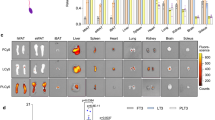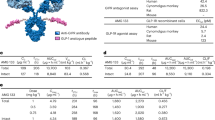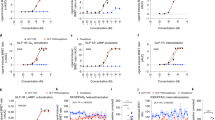Abstract
Background/Objectives:
Our objective was to assess the sustained, low-dose and constant administration of the thyroid receptor-β (TRβ)-selective agonist GC-1 (sobetirome) from a novel nanochannel membrane device (NMD) for drug delivery. As it known to speed up metabolism, accomplish weight loss, improve cholesterol levels and possess anti-diabetic effects, GC-1 was steadily administered by our NMD, consisting of an implantable nanochannel membrane, as an alternative to conventional daily administration, which is subject to compliance issues in clinical settings.
Subjects/Methods:
Diet-induced obese C57BL/J6 male mice were fed a very high-fat diet (VHFD) and received NMD implants subcutaneously. Ten mice per group received capsules containing GC-1 or phosphate-buffered saline (control). Weight, lean and fat mass, as well as cholesterol, triglycerides, insulin and glucose, were monitored for 24 days. After treatment, plasma levels of thyroid-stimulating hormone (TSH) and thyroxine were compared. mRNA levels of a panel of thermogenic markers were examined using real-time PCR in white adipose tissue (WAT) and brown adipose tissue (BAT). Adipose tissue, liver and local inflammatory response to the implant were examined histologically. Pancreatic islet number and β-cell area were assessed.
Results:
GC-1 released from the NMD reversed VHFD-induced obesity and normalized serum cholesterol and glycemia. Significant reductions in body weight and fat mass were observed within 10 days, whereas reductions in serum cholesterol and glucose levels were seen within 7 days. The significant decrease in TSH was consistent with TRβ selectivity for GC-1. Levels of transcript for Ucp1 and thermogenic genes PGC1a, Cidea, Dio2 and Cox5a showed significant upregulation in WAT in NMD–GC-1-treated mice, but decreased in BAT. Although mice treated by NMD–GC-1 showed a similar number of pancreatic islets, they exhibited significant increase in β-cell area.
Conclusions:
Our data demonstrate that the NMD implant achieves steady administration of GC-1, offering an effective and tightly controlled molecular delivery system for treatment of obesity and metabolic disease, thereby addressing compliance.
This is a preview of subscription content, access via your institution
Access options
Subscribe to this journal
Receive 12 print issues and online access
$259.00 per year
only $21.58 per issue
Buy this article
- Purchase on Springer Link
- Instant access to full article PDF
Prices may be subject to local taxes which are calculated during checkout






Similar content being viewed by others
References
World Health Organization. Obesity and Overweight. http://www.who.int/dietphysicalactivity/childhood/en/ (accessed 22 March 2015).
The National League of Cities. Economic Costs of Obesity. http://www.healthycommunitieshealthyfuture.org/learn-the-facts/economic-costs-of-obesity/ (accessed: 20 December 2015).
Saito M, Okamatsu-Ogura Y, Matsushita M, Watanabe K, Yoneshiro T, Nio-Kobayashi J et al. High incidence of metabolically active brown adipose tissue in healthy adult humans: effects of cold exposure and adiposity. Diabetes 2009; 58: 1526–1531.
Chondronikola M, Volpi E, Borsheim E, Porter C, Annamalai P, Enerback S et al. Brown adipose tissue improves whole-body glucose homeostasis and insulin sensitivity in humans. Diabetes 2014; 63: 4089–4099.
Stanford KI, Goodyear LJ . The therapeutic potential of brown adipose tissue. Hepatobiliary Surg Nutr 2013; 2: 286–287.
Harms M, Seale P . Brown and beige fat: development, function and therapeutic potential. Nat Med 2013; 19: 1252–1263.
Castillo M, Freitas BCG, Rosene ML, Drigo RA, Grozovsky R, Maciel RMB et al. Impaired metabolic effects of a thyroid hormone receptor beta-selective agonist in a mouse model of diet-induced obesity. Thyroid 2010; 20: 545–553.
Chiellini G, Apriletti JW, Yoshihara HA, Baxter JD, Ribeiro RC, Scanlan TS . A high-affinity subtype-selective agonist ligand for the thyroid hormone receptor. Chem Biol 1998; 5: 299–306.
Scanlan TS . Sobetirome: a case history of bench-to-clinic drug discovery and development. Heart Fail Rev 2010; 15: 177–182.
Moisan A, Lee Y-K, Zhang JD, Hudak CS, Meyer CA, Prummer M et al. White-to-brown metabolic conversion of human adipocytes by JAK inhibition. Nat Cell Biol 2014; 17: 57–67.
Baxter JD, Webb P . Thyroid hormone mimetics: potential applications in atherosclerosis, obesity and type 2 diabetes. Nat Rev Drug Discov 2009; 8: 308–320.
Berkenstam A, Kristensen J, Mellström K, Carlsson B, Malm J, Rehnmark S et al. The thyroid hormone mimetic compound KB2115 lowers plasma LDL cholesterol and stimulates bile acid synthesis without cardiac effects in humans. Proc Natl Acad Sci USA 2008; 105: 663–667.
Angelin B, Kristensen JD, Eriksson M, Carlsson B, Klein I, Olsson AG et al. Reductions in serum levels of LDL cholesterol, apolipoprotein B, triglycerides and lipoprotein(a) in hypercholesterolaemic patients treated with the liver-selective thyroid hormone receptor agonist eprotirome. J Intern Med 2015; 277: 331–342.
Ladenson PW, Kristensen JD, Ridgway EC, Olsson AG, Carlsson B, Klein I et al. Use of the thyroid hormone analogue eprotirome in statin-treated dyslipidemia. N Engl J Med 2010; 362: 906–916.
Sjouke B, Langslet G, Ceska R, Nicholls SJ, Nissen SE, Öhlander M et al. Eprotirome in patients with familial hypercholesterolaemia (the AKKA trial): a randomised, double-blind, placebo-controlled phase 3 study. Lancet Diabetes Endocrinol 2014; 2: 455–463.
Boyer SH, Jiang H, Jacintho JD, Reddy MV, Li H, Li W et al. Synthesis and biological evaluation of a series of liver-selective phosphonic acid thyroid hormone receptor agonists and their prodrugs. J Med Chem 2008; 51: 7075–7093.
Cable EE, Finn PD, Stebbins JW, Hou J, Ito BR, van Poelje PD et al. Reduction of hepatic steatosis in rats and mice after treatment with a liver-targeted thyroid hormone receptor agonist. Hepatology 2009; 49: 407–417.
Ferrati S, Fine D, You J, De Rosa E, Hudson L, Zabre E et al. Leveraging nanochannels for universal, zero-order drug delivery in vivo. J Control Release 2013; 172: 1011–1019.
Ferrati S, Nicolov E, Zabre E, Geninatti T, Shirkey BA, Hudson L et al. The nanochannel delivery system for constant testosterone replacement therapy: nanochannel implant for testosterone replacement. J Sex Med 2015; 12: 1375–1380.
Lenhard MJ, Reeves GD . Continuous subcutaneous insulin infusion: a comprehensive review of insulin pump therapy. Arch Intern Med 2001; 161: 2293.
Mecklenburg RS, Benson EA, Benson JW, Fredlund PN, Guinn T, Metz RJ et al. Acute complications associated with insulin infusion pump therapy. Report of experience with 161 patients. JAMA 1984; 252: 3265–3269.
Pietri A, Raskin P . Cutaneous complications of chronic continuous subcutaneous insulin infusion therapy. Diabetes Care 1981; 4: 624–626.
Fine D, Grattoni A, Hosali S, Ziemys A, De Rosa E, Gill J et al. A robust nanofluidic membrane with tunable zero-order release for implantable dose specific drug delivery. Lab Chip 2010; 10: 3074–3083.
Grattoni A, Shen H, Fine D, Ziemys A, Gill JS, Hudson L et al. Nanochannel technology for constant delivery of chemotherapeutics: beyond metronomic administration. Pharm Res 2011; 28: 292–300.
Ferrati S, Nicolov E, Bansal S, Zabre E, Geninatti T, Ziemys A et al. Delivering enhanced testosterone replacement therapy through nanochannels. Adv Healthc Mater 2015; 4: 446–451.
Nicolov E, Ferrati S, Goodall R, Hudson L, Hosali S, Crowley M et al. Nanotechnology-based implant for long term testosterone replacement. J Urol 2014; 191: e485–e486.
Martagón AJ, Lin JZ, Cimini SL, Webb P, Phillips KJ . The amelioration of hepatic steatosis by thyroid hormone receptor agonists is insufficient to restore insulin sensitivity in Ob/Ob mice. PLoS ONE 2015; 10: e0122987.
Scanlan TS .Safety and pharmacodynamic study of sobetirome in X-linked adrenoleukodystrophy (X-ALD). Oregon, USA. 2013. https://clinicaltrials.gov/ct2/show/NCT01787578?term=sobetirome&rank=1.
Tancevski I, Demetz E, Eller P . Sobetirome: a selective thyromimetic for the treatment of dyslipidemia. Recent Pat Cardiovasc Drug Discov 2011; 6: 16–19.
Joharapurkar AA, Dhote VV, Jain MR . Selective thyromimetics using receptor and tissue selectivity approaches: prospects for dyslipidemia. J Med Chem 2012; 55: 5649–5675.
Scanlan TS, Hartley M, Placzek A, Righi M . Use of sobetirome in the treatment of X-linked adrenolenoleukodystrophy. http://www.freepatentsonline.com/WO2014178892.html, filed 08 May 2013, and issued 11 June 2014.
QuatRx Pharmaceuticals. Phase 1 Studies show promise of QuatRx’s novel compound, sobetirome, for lowering LDL cholesterol levels http://www.prnewswire.com/news-releases/phase-1-studies-show-promise-of-quatrxs-novel-compound-sobetirome-for-lowering-ldl-cholesterol-levels-57396872.html.
Villicev CM, Freitas FRS, Aoki MS, Taffarel C, Scanlan TS, Moriscot AS et al. Thyroid hormone receptor beta-specific agonist GC-1 increases energy expenditure and prevents fat-mass accumulation in rats. J Endocrinol 2007; 193: 21–29.
White P, Burton KA, Fowden AL, Dauncey MJ . Developmental expression analysis of thyroid hormone receptor isoforms reveals new insights into their essential functions in cardiac and skeletal muscles. FASEB J 2001; 15: 1367–1376.
Trost SU, Swanson E, Gloss B, Wang-Iverson DB, Zhang H, Volodarsky T et al. The thyroid hormone receptor-β-selective agonist GC-1 differentially affects plasma lipids and cardiac activity. Endocrinology 2000; 141: 3057–3064.
Baxter JD, Webb P, Grover G, Scanlan TS . Selective activation of thyroid hormone signaling pathways by GC-1: a new approach to controlling cholesterol and body weight. Trends Endocrinol Metab 2004; 15: 154–157.
Yeadon J. Choosing among type II diabetes mouse models 2015, https://www.jax.org/news-and-insights/jax-blog/2015/july/choosing-among-type-ii-diabetes-mouse-models (accessed 20 December 2015).
Bielohuby M, Popp S, Bidlingmaier M . A guide for measurement of circulating metabolic hormones in rodents: Pitfalls during the pre-analytical phase. Mol Metab 2012; 1: 47–60.
Bellomo G, Sulas MG, Mairate E, Bardone MB, Rolla R . Hemolysis is a major cause of variability in insulin measurement during oral glucose tolerance test in children. Clin Lab 2012; 58: 67–74.
Freitas FRS, Moriscot AS, Jorgetti V, Soares AG, Passarelli M, Scanlan TS et al. Spared bone mass in rats treated with thyroid hormone receptor TRβ-selective compound GC-1. Am J Physiol Endocrinol Metab 2003; 285: E1135–E1141.
Grover GJ, Egan DM, Sleph PG, Beehler BC, Chiellini G, Nguyen N-H et al. Effects of the thyroid hormone receptor agonist GC-1 on metabolic rate and cholesterol in rats and primates: selective actions relative to 3,5,3’-triiodo-L-thyronine. Endocrinology 2004; 145: 1656–1661.
Gonçalves A, Tolentino CC, de Souza FR, da Costa Huss JC, de Lourdes Zinato K, Lopes LTP et al. The thyroid hormone receptor β-selective agonist GC-1 does not affect tolerance to exercise in hypothyroid rats. Arch Endocrinol Metab 2015; 59: 141–147.
Young P, Arch JR, Ashwell M . Brown adipose tissue in the parametrial fat pad of the mouse. FEBS Lett 1984; 167: 10–14.
Loncar D . Convertible adipose tissue in mice. Cell Tissue Res 1991; 266: 149–161.
Rosenwald M, Wolfrum C . The origin and definition of brite versus white and classical brown adipocytes. Adipocyte 2014; 3: 4–9.
Walden TB, Hansen IR, Timmons JA, Cannon B, Nedergaard J . Recruited vs. nonrecruited molecular signatures of brown, ‘brite,’ and white adipose tissues. Am J Physiol Endocrinol Metab 2012; 302: E19–E31.
Lin JZ, Martagón AJ, Cimini SL, Gonzalez DD, Tinkey DW, Biter A et al. Pharmacological activation of thyroid hormone receptors elicits a functional conversion of white to brown fat. Cell Rep 2015; 13: 1528–1537.
Brereton MF, Iberl M, Shimomura K, Zhang Q, Adriaenssens AE, Proks P et al. Reversible changes in pancreatic islet structure and function produced by elevated blood glucose. Nat Commun 2014; 5: 4639.
Sabek OM, Nishimoto SK, Fraga D, Tejpal N, Ricordi C, Gaber AO . Osteocalcin effect on human β-cells mass and function. Endocrinology 2015; 156: 3137–3146.
Ferron M, McKee MD, Levine RL, Ducy P, Karsenty G . Intermittent injections of osteocalcin improve glucose metabolism and prevent type 2 diabetes in mice. Bone 2012; 50: 568–575.
Ferrati S, Nicolov E, Bansal S, Hosali S, Landis M, Grattoni A . Docetaxel/2-hydroxypropyl β-cyclodextrin inclusion complex increases docetaxel solubility and release from a nanochannel drug delivery system. Curr Drug Targets 2015; 16: 1645–1649.
Gupte AA, Sabek OM, Fraga D, Minze LJ, Nishimoto SK, Liu JZ et al. Osteocalcin protects against nonalcoholic steatohepatitis in a mouse model of metabolic syndrome. Endocrinology 2014; 155: 4697–4705.
Huang Y-Y . Cross-talk between the thyroid and liver: a new target for nonalcoholic fatty liver disease treatment. World J Gastroenterol 2013; 19: 8238.
Amorim BS, Ueta CB, Freitas BC, Nassif RJ, Gouveia CH, Christoffolete MA et al. A TRbeta -selective agonist confers resistance to diet-induced obesity. J Endocrinol 2009; 203: 291–299.
Burris TP, Solt LA, Wang Y, Crumbley C, Banerjee S, Griffett K et al. Nuclear receptors and their selective pharmacologic modulators. Pharmacol Rev 2013; 65: 710–778.
Grover GJ, Mellström K, Ye L, Malm J, Li Y-L, Bladh L-G et al. Selective thyroid hormone receptor-beta activation: a strategy for reduction of weight, cholesterol, and lipoprotein (a) with reduced cardiovascular liability. Proc Natl Acad Sci USA 2003; 100: 10067–10072.
Johansson L, Rudling M, Scanlan TS, Lundasen T, Webb P, Baxter J et al. Selective thyroid receptor modulation by GC-1 reduces serum lipids and stimulates steps of reverse cholesterol transport in euthyroid mice. Proc Natl Acad Sci USA 2005; 102: 10297–10302.
Lin JZ, Martagón AJ, Hsueh WA, Baxter JD, Gustafsson J-Å, Webb P et al. Thyroid hormone receptor agonists reduce serum cholesterol independent of the LDL receptor. Endocrinology 2012; 153: 6136–6144.
Yuan C, Lin JZH, Sieglaff DH, Ayers SD, Denoto-Reynolds F, Baxter JD et al. Identical gene regulation patterns of T3 and selective thyroid hormone receptor modulator GC-1. Endocrinology 2012; 153: 501–511.
Acknowledgements
We thank Carlos Favela and Dr Kemi Cui from the advanced cellular and tissue microscopy core, Dr Jianhua (James) Gu from the electron microscopy core, Dr Andreana L. Rivera and Dr Yulan Ren from the research pathology core, Solmaz Afshar for assistance with liver histology and Dr Aijun Zhang for assistance with the Eppendorf EpMotion 5075 automated pipetting system. We also thank the Pharmaceutical Science Facility, Institute of Applied Cancer Science, UT MD Anderson Cancer Center for liquid chromatography–tandem mass spectrometry analysis. This work was supported by start-up funds from Houston Methodist Research Institute (AG).
Author information
Authors and Affiliations
Corresponding author
Ethics declarations
Competing interests
AG discloses a financial interest in NanoMedical Systems, Inc. All other authors declare no conflict of interest.
Additional information
Supplementary Information accompanies this paper on International Journal of Obesity website
Rights and permissions
About this article
Cite this article
Filgueira, C., Nicolov, E., Hood, R. et al. Sustained zero-order delivery of GC-1 from a nanochannel membrane device alleviates metabolic syndrome. Int J Obes 40, 1776–1783 (2016). https://doi.org/10.1038/ijo.2016.129
Received:
Revised:
Accepted:
Published:
Issue Date:
DOI: https://doi.org/10.1038/ijo.2016.129
This article is cited by
-
Pharmacological modulation of adaptive thermogenesis: new clues for obesity management?
Journal of Endocrinological Investigation (2023)
-
Advanced implantable drug delivery technologies: transforming the clinical landscape of therapeutics for chronic diseases
Biomedical Microdevices (2019)
-
Unexpected behaviors in molecular transport through size-controlled nanochannels down to the ultra-nanoscale
Nature Communications (2018)
-
Efficacy of sustained delivery of GC-1 from a Nanofluidic system in a spontaneously obese non-human primate: a case study
Biomedical Microdevices (2018)



